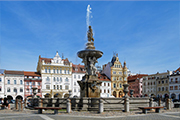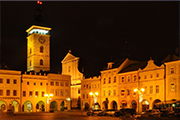The town is situated in the České Budějovice basin, at the confluence of Vltava and Malše Rivers. There is a number of historical monuments and museums in České Budějovice and also many historically valuable sites in its close vicinity (Hluboká nad Vltavou, Český Krumlov, Holašovice, Vyšší Brod, Zlatá Koruna, Třeboň, etc.) that attract tourists.
The greatest tourist attractions can be found in the historical centre with plenty of medieval architecture. Especially around the large Přemysl Otakar II Square, that ranks among the most beautiful squares in the country. It is square-shaped and 1 hectare large, and is surrounded with Baroque burgher houses with arcades. In the middle of the square stands the baroque Samson’s Fountain with a statue of Samson fighting a lion. The most significant buildings are the Baroque Town Hall, the Black Tower ("Černá věž") and the Baroque Church of St. Nicolas. A charming, quiet place full of history is the Piaristic Square, with the oldest buildings of the Gothic Dominican monastery with the Church of the Blessed Virgin’s Sacrifice and the late Rennaissance Solnice.
České Budějovice is famous for its beer brewed there since the 13th century. Budweiser Budvar became, along with the Pilsner Urquell from Plzeň, one of the best-known lagers.





